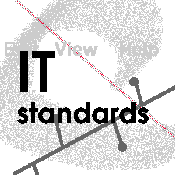
The Network Computer and the NetPC.
By Ron Mackley
NetPC
Players
Microsoft and Intel are the authors of the standard. They are backed by PC manufacturers such as Gateway 2000, Dell, DEC, Hewlett Packard, Packard Bell, NEC, and Texas Instruments
Standards
The NetPC is built on Windows and the Intel x86 architecture The most noteworthy additions are the Unique ID for each machine and peripheral, the low noise level, and the lack of expansion slots.
The specification, from Microsoft is:
- Pentium(r) processor, 100 MHz or greater
- 16 MB minimum system memory
- Support for an internal hard disk for caching
- External keyboard connection
- External pointing device connection
- VGA-compatible display adapter with a minimum 640x480 resolution, 8 bpp
- Support for one of the following: Ethernet, token ring, 28.8 Kbps modem, ISDN, T1 or ATM
- Buses and drivers compliant with current Plug and Play specification
- Unique Plug and Play device identification for each system device and add-on device
- Protection preventing users from incorrectly connecting to devices
- Minimal user interaction for installing and configuring devices
- Device drivers and installation that meet the specifications of the Windows and WindowsNT(r) operating systems
- Audio capability
- A machine-readable unique ID for each machine
- Audible noise quieter than 35 dBA
- Lockable PC case
- No end-user expansion slots
The Universal Serial Bus has been included as an optional item for the NetPC. It can serve as a bus for adding peripherals from keyboards and mice to disk drives and scanners.
Target
Business Desktops-the NetPC is targeted at the corporate network environment. The Zero Ownership Cost initiative with which it is closely linked is meant to reduce the cost of maintaining a network of PC's. Because it lacks a large hard disk, this is not a machine for a single, home user.
Motivations
Zero Administration Initiative.
Zero Administration initiative is an effort by the PC hardware industry to reduce the cost of maintaining desktop PC's in the enterprise. Key to it is the centralization of administration. Serve applications and user profiles centrally and better spend effort on maintaining the server, making the individual PC's cheap and replaceable.
Keep a PC on every desktop.
It should not be overlooked that the NetPC is being sold in part to a captive market. Windows is the most widely installed desktop operating system and the NetPC is not going to change that. By lowering the cost of maintaining an installed base, the NetPC will strengthen Windows' hold on the enterprise.
Location Independence.
Part and parcel to central administration of application and user data is location independence--the ability to work on any machine on a network as with access to personal data and individual configuration parameters such as styles, templates, and macros.
Down sides
Like the Network Computer, substantial network infrastructure updates may be required to use NetPC's because they too rely heavily on servers for applications and user data. (Computer World, January 27, 997)
Discussion
The appeal of the NetPC is that it is built almost entirely upon a single existing deployed standard - Windows. The migration path to come into line with this standard is short and most installations can be compliant with its core requirements very easily. Pentium PC's with 16MB RAM are common. Other requirements - no expansion slots and no floppy nor CD-ROM - are a change from standard fare from PC vendors. I do not think it would be difficult to convince administrators to choose NetPC's over regular PC's, however. The Zero Ownership Cost initiative is compelling and arguments are presented such that there is nothing to lose and much to gain.
The NetPC is not suitable for every user. Key to its function is a strong server and networking back end. Some environments may not be able to handle the network traffic generated by the heavy server access necessitated by the NetPC. Sensitive data may be better left on local disk than on a server where the possible points of failure are fewer.
Many of the technologies presented here are hardly new. Unix workstations have had 'dataless clients' for many years and the gist of USB has been presented before as ADB and later, FireWire. Windows is not new technology, either. What will most move administrators to the NetPC will be it's reliance upon existing standards and the promise of reduced administration costs.
Fleets of existing PC's will not have to be discarded to make way for this new technology. It is possible to ease into the NetPC standard.
Introduction
Network Computer
NetPC
Discussion
Links
IT Standards Home
Sun Mar 16 19:42:05 EST 1997
under construction
rgm@sis.pitt.edu